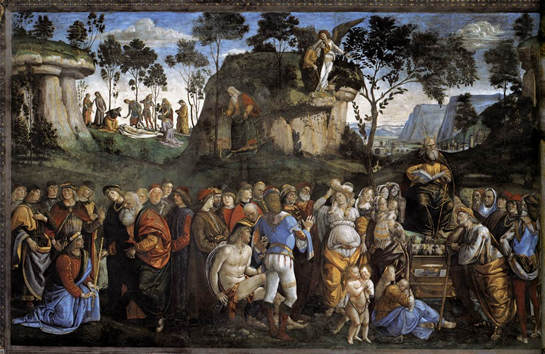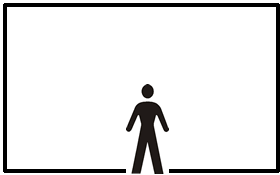 |
 |
 |
 |
 |
 |
 |
Testament et mort de Moïse

Luca Signorelli, 1481-82
Fresque 350 x 572 cm
Fresques de la vie de Moïse pour la Sixtine, Vatican

La fresque est tirée du cycle de la vie de Moïse de la Chapelle Sixtine. Elle se trouve dans le sixième compartiment du mur sud.
La fresque représente les derniers épisodes de la vie de Moïse. A droite, Moïse, âgé de cent vingt ans, est assis sur une élévation, tenant son bâton et des rayons d'or encerclent sa tête. Aux pieds de Moïse se trouve l'arche de l'Alliance, ouverte pour montrer le vase de manne à l'intérieur et les deux tables de la loi. Dans la moitié gauche de l'image, Josué est désigné comme successeur de Moïse. Josué s'agenouille devant Moïse, qui lui donne son bâton. Au centre de l'arrière-plan, nous voyons Moïse conduit par l'ange du Seigneur sur le mont Nébo, d'où il pourra contempler la Terre promise dans laquelle, par la volonté de Dieu, il n'entrera jamais. Au pied de la montagne, nous le voyons à nouveau, se tournant vers la gauche. Sa mort est représentée à l'arrière-plan, dans le pays de Moab, où les enfants d'Israël le pleurèrent pendant trente jours.
Signorelli devait avoir un peu plus de trente ans lorsqu'il participa à la décoration de la chapelle Sixtine. Le nom de Luca ne figure pas parmi le groupe d'artistes toscans et ombriens (Cosimo Rosselli, Botticelli, Ghirlandaio et Perugino) qui, le 27 octobre 1481, signèrent le contrat pour la décoration des murs latéraux de la célèbre chapelle, qui devaient être décorés de fresques de scènes bibliques. Mais Vasari est absolument certain de son implication et sa main est évidente dans certains détails de la grande scène du Testament et de la Mort de Moïse. Le tableau, du moins tel qu'il nous apparaît aujourd'hui, est pour l'essentiel l'œuvre de Bartolomeo della Gatta, reflétant son utilisation typique de couleurs vives et d'éclairages subtils. Mais, parmi les nombreuses figures qui peuplent la scène, certaines sont d'une description anatomique pleine d'énergie et transmettent des émotions fortes : le jeune nu assis au centre, par exemple, ou les deux personnages habillés représentés dos au spectateur, ou encore l'homme au bâton appuyé contre le trône de Moïse. La main de Luca Signorelli apparaît de manière assez évidente dans ces détails, comme dans d'autres.
